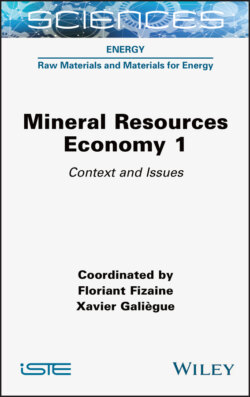Читать книгу Mineral Resource Economics 1 - Florian Fizaine, Xavier Galiegue - Страница 2
Table of Contents
Оглавление1 Cover
2 Title Page
3 Copyright
4 Introduction I.1. Why are mineral resources important? I.1. Should we fear a new mineral jump caused by the decarbonation of energy? I.1. Systemic mechanics associated with multiple corollaries: insights provided by interdisciplinarity I.1. References
5 PART 1: Background 1 Assessment of European Demand for Mineral Resources by Material Flow Analyses: The Case of Cobalt 1.1. Introduction 1.2. Cobalt market: structure and operation 1.3. A method combining value chain analysis and material flow analysis 1.4. Results of and discussions on cobalt flow analysis in the European Union 1.5. Conclusion 1.6. Appendix: quantities of cobalt contained in primary and refined streams, recycling rates, and cobalt waste management 1.7. References 2 Financialization of the Minerals and Metals Market: Origin, Challenges and Prospects 2.1. Introduction 2.2. Dynamics of financialization: understanding the heterogeneity of the minerals and metals sector 2.3. Effects of financialization: from price dynamics to value chain change 2.4. Conclusion 2.5. References 3 Geopolitics of Metals: Between Strategies of Power and Influence 3.1. Introduction 3.2. Natural resources doctrine 3.3. Abundant, sensitive, critical, and strategic metals 3.4. Competitive consumption 3.5. Proliferation of “unobtanium metals” 3.6. Strategy of influence, strategic stock, and exploration 3.7. Conclusion 3.8. References 4 Mineral Wealth Endowment, a Construct 4.1. Introduction 4.2. Mineral endowment, an attempt at clarification 4.3. Unequal distribution of resources 4.4. Discussion: building mining endowment 4.5. Conclusion 4.6. Acknowledgements 4.7. References
6 PART 2: Issues 5 Modeling the Long-Term Evolution of Primary Production Energy and Metal Prices 5.1. Introduction 5.2. Relationship between concentration and production energy 5.3. Equivalence between energy and price 5.4. Technological improvement and evolution of production energy and metal prices over time 5.5. Application to copper primary production 5.6. Application to nickel, aluminum, silver, and gold 5.7. Conclusion 5.8. References 6 Environmental Footprint of Mineral Resources 6.1. Introduction 6.2. Notion of environmental footprint 6.3. Principles of input–output analysis 6.4. Towards IOTs extended to the environment 6.5. Calculation of environmental footprints of metals by MRIO analysis 6.6. Conclusion 6.7. References 7 Why Should We Fear Energy and Material Savings? Deconstructing a Sustainability Myth 7.1. Introduction 7.2. Conceptual critique of the “eco-efficiency” principle 7.3. Rebound effects or unintended consequences of “producing more with less” at the macrosystemic level 7.4. Conclusion 7.5. References 8 The “Resource Curse” in Developing Mining Countries 8.1. Introduction 8.2. How to take into account the contribution of exhaustible resources to sustainability and measure the “resource curse” 8.3. Mining activity and the “resource curse”: macroeconomic and sectoral issues 8.4. Mining income: an unstable and toxic income for States 8.5. Is the “resource curse” inevitable? 8.6. Conclusion 8.7. References 9 Industrial and Artisanal Exploitation of Natural Resources: Impacts on Development 9.1. Introduction 9.2. Impacts of industrial extraction 9.3. The case of artisanal mines 9.4. Conclusion 9.5. Acknowledgements 9.6. References
7 Conclusion C.1. Mineral resources issues, object of human representation C.2. Some enlightenment regarding physico-socio-economic feedback C.3. References
8 List of Authors
9 Index
10 End User License Agreement
